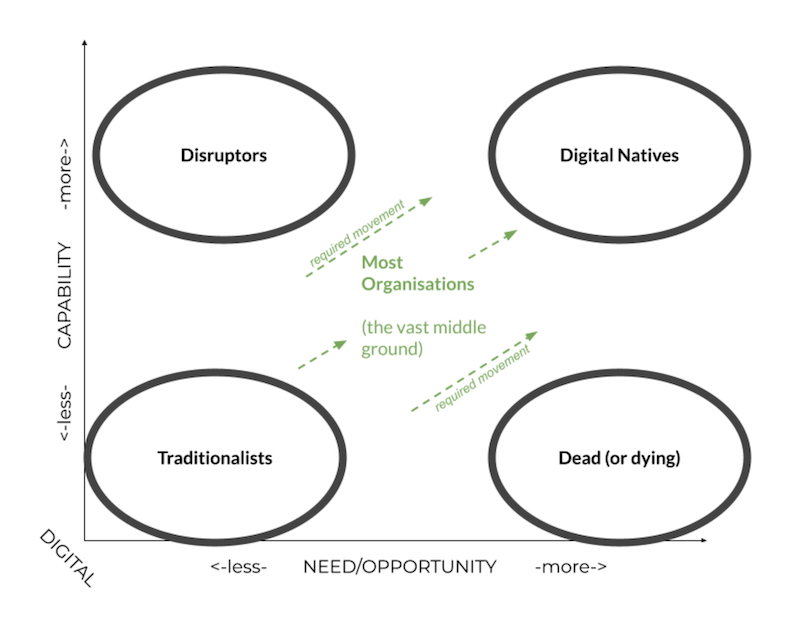Stemming from the Latin ‘digitus’, the word ‘digital’ has certainly seen some fluctuations in meaning and popularity over the years. From its initial use in audio media, the word seems to have evolved and shifted in definition, and is now omnipresent within business and industry.
More and more businesses are creating a role for a Chief Digital Officer, reflecting a global move towards a digital future. These CDOs are often responsible for driving growth by evolving their organisation into the digital age – but how? It begins with an understanding of where the organisation sits today, and where it needs to be in the future.
By exploring the needs and opportunities within our market and the digital capabilities available to us, we can start to develop an understanding of how ‘mature’ our organisation is. This gives us the insights we need to drive technical strategies, and support the economic success of our businesses.
There are lots of ways we can assess our organisation’s digital maturity – some very detailed and complicated. But there’s an easy way to do a quick check, and it’s this simple mapping system we’re going to explore here.
The digital maturity map
Maturity maps are often met with a lack of enthusiasm. If not done correctly, they can be manipulated to suit our requirements – used as either an impetus for change in a specific direction, or a vanity metric to add weight to a spurious claim of victory. However, if used genuinely – to improve situational awareness, guide the direction of travel and measure progress, they can be a really valuable tool.
This map is represented as a two-dimensional matrix. We need to honestly plot our organisation’s needs, opportunities and capabilities within this matrix. We use this to find clusters found in the corners of the map – although many organisations will find themselves hovering around the middle. These clusters can be categorised in the following ways:
- Digital Natives – Tech giants or scale-ups born in digital. With a breadth of mature digital capabilities, they drive the market to new needs and take advantage of emerging opportunities
- Disruptors – Primarily start-ups (and occasionally corporate intrapreneurs), they identify new digital opportunities, and demand explodes once a capability has been demonstrated (Uber, for example)
- Traditionalists – Those with pre-digital strongholds. Often very established and successful businesses, they don’t see an urgent need to grow digital capabilities
- Dead or Dying – Those that fail to build the digital capabilities required to meet emerging needs (Blockbuster, for example)

Digital maturity matrix
Although you may not see your organisation fitting into any of these stereotypes, you might still be able to appreciate the threats they present – not only the threat from those organisations, but also of becoming one of them!
It’s also worth noting that, although we’ve been talking about mapping entire organisations, this technique can work equally well for individual departments, products or propositions.
The need/opportunity dimension
Use the horizontal axis to mark how much need or opportunity there is for your organisation to have digital capabilities. This will be influenced by your market, but isn’t just comparative to your competitors. It’s also driven by the expectations of existing customers, prospects and other industries.
There are certain situations that are likely to increase your need for digital capabilities, for example:
- Having a large number of customers with low-value transactions – these businesses often have a more immediate need that those that rely on a small number of high-value customers, highlighting the importance of being able to meet market needs at scale
- Reliance on large internal operational teams – areas where staff are doing repetitive or manual tasks offer great opportunities to reduce costs, give better value to customers and scale quickly when the opportunity occurs
- Disruption to the industry by competitors – businesses with capabilities above the wider market present a better future for customers, which can drive new needs and opportunities
- Evolving consumer experiences – expectations from one industry spread to other industries
We can see an example of how quickly these needs can change in a customer of Equal Experts, the John Lewis Partnership – a €13 billion p.a. retailer. During the pandemic, the closure of physical stores gave JLP the immediate need to shift face-to-face interactions with customers to online channels. Fortunately, JLP had already invested heavily in digital, which meant it could respond appropriately and survive the challenge.
Organisations that don’t stay ahead of their market needs or aren’t able to effectively respond to change will typically suffer a slow (or perhaps rapid!) decline.
The capability dimension
Use the vertical axis to mark your organisation’s current digital capabilities. The higher on this scale your organisation is, the more likely you will be able to respond to emerging technology trends.
Organisations can find themselves drifting down the capability scale if they aren’t continuously evolving – and those that don’t keep up with new technologies and capabilities are much more likely to decay over time.
There are some common characteristics between organisations who are able to provide the digital capabilities demanded by their markets. Making sure your business also displays these characteristics will increase your ability to effectively respond to demands from your market.
- Understanding end-user needs – truly understanding the needs of your end-users is the ultimate tool in being sensitive to changing digital needs and opportunities in the market
- Internal product development capabilities – teams that can autonomously react to changing demands, deliver new features and test new ideas are essential in a successful digital organisation
- Strong partnerships – focus internal capabilities on differentiators, and build stable relationships with suppliers for additional commodity needs
- Agility in budgets and funding – failing to focus your funding in the right place at the right time can prevent an organisation from adapting to what the market needs. Successful businesses provide consistency, allow incremental commitment and support experimentation
Creating movement on the map
The aim of any technology leader is to create movement up the mobility map, in order to meet the natural movement of their market. To do this, leaders should think holistically, work iteratively and build continuously.
Think holistically
Successful digital capabilities require an intricate web of technologies, processes, and customer touchpoints. While narrow perspectives can be damaging, holistic thinking gives us a deeper understanding, and allows us to consider the long-term implications of digital initiatives.
Work iteratively
An iterative mindset helps organisations adapt to rapidly changing landscapes and market trends. The cycle of learning, experimenting and improving keeps strategies relevant and effective. It helps identify and address potential weaknesses, and ensures improvements are aligned with customer expectations.
Build continuously
Digital maturity is a journey, not a destination. It empowers businesses to stay ahead of the competition, allows swift responses to changing markets and effective harnessing of emerging technology. By adopting a mindset of continuous improvement, organisations can optimise their capabilities, meet market needs, and drive long-term success.


